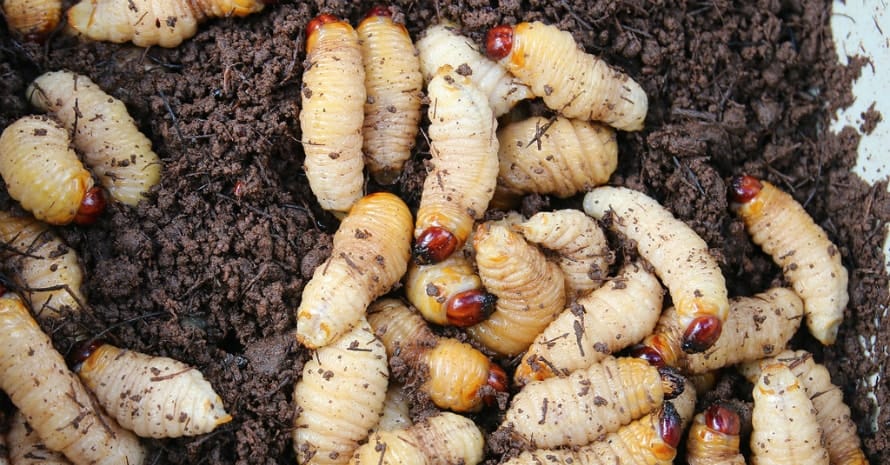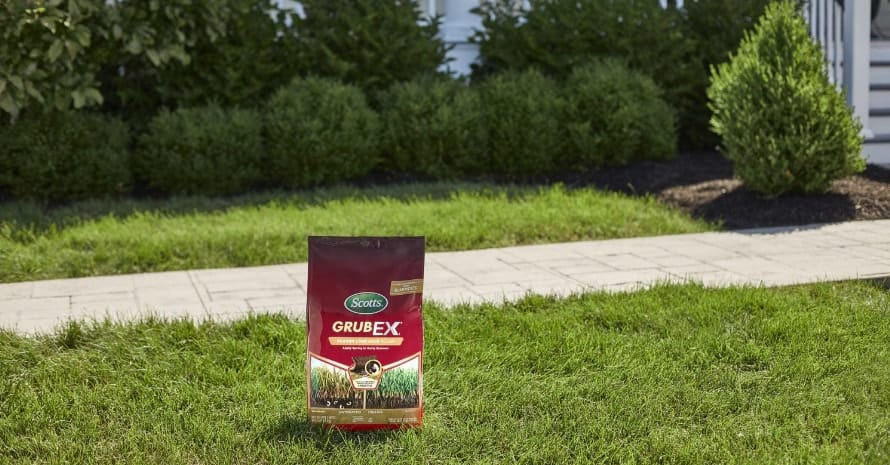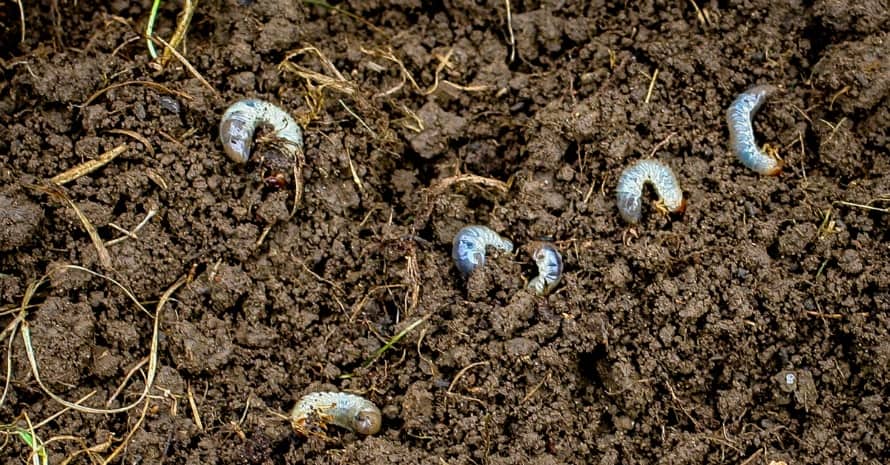Few people enjoy the sight of fat, slick, worm-like creatures with tiny legs that make them look like unsightly shrimps. Not only are grubs ugly; they also damage your garden. The little things feed on roots, causing the plants to slowly die of malnourishment and water shortage. They hurt our backyards in other, indirect ways, too.
Sounds bad, doesn’t it? Don’t panic, though. I’m here to tell you how to get rid of grubs for good and share with you three products that I’ve found efficient in dealing with grub infestation. But first, know your enemy!
What Are Grubs and How to Spot Them?

Although commonly referred to as grub worms, grubs are not a separate species but rather an umbrella term for the larval stage of certain chafers and beetles. The species that’s most commonly held responsible for grub damage is the Japanese beetle. These are common in sunny parts of the lawn and generally lay their eggs in summer.
The reason why beetles choose to place their larvae in soil is that the babies feed on plant roots. This brings about lawn damage as one of the key signs that you are dealing with grub infestation — small, irregularly placed patches of brown, wilted grass usually appear. You might also find your plants suddenly dead or dying, with droopy leaves.
Sometimes the ground feels springy when you step on it. You can check the situation by lifting the grass, and looking at the top soil level (grass “peeling” easily can be a sign of badly damaged roots, too). A healthy lawn can generally handle up to ten grub worms per square foot; seeing more is surely a red flag.
Apart from munching on roots and thus dooming your well-loved plants to a slow death, grubs attract many nuisance animals. Moles, skunks and raccoons can all be attracted by the nutritious “worms”, which is not the most beneficial scenario for your vegetable patch/flowers/patio in general.

Okay, I Have Grubs. How Do I Send Them Packing?
When it comes to getting rid of grubs, integrated pest management is unparalleled. The term stands for responsible use of pesticides and biological controls combined with monitoring and prevention.
That is, rather than going nuclear with harsh chemicals and then forgetting about the problem until it re-emerges, it’s best to keep an eye open for signs of a growing grub population.
Step 1: Start by Killing Grubs with a Chemical

One possible way of reducing the grub population is by applying an anti-grub insecticide.
The market has a lot to offer in terms of chemicals that kill grubs in garden soil. Some pesticides come with preventive potential (see Step 2); these work best when applied in late spring to early summer. However, in late summer to fall, when the grubs are large and already feeding, curative products based on carbaryl, trichlorfon, or zeta-cypermethrin are the only option.
These tend to kill beneficial insects as well as pests, though. It might be a wise decision to wait for the next window where you can apply prevention as described in Step 2 or resort to Alternative Step 1 as a healthier alternative. If you choose to use curative chemicals, remember to water them in. The later in the season, the more.
Alternative Step 1: Use Organic Controls
You might want to steer away from aggressive chemicals by applying organic grub removal methods. These fall into two major categories, namely plant-based repellents and biological controls.
The former is represented predominantly by neem oil, a natural insecticide extracted from the Azadirachta indica tree that prevents egg-laying and feeding. It is commonly applied as a water solution, which is sprayed on affected areas of turf.
The latter category includes beneficial nematodes and milky spore.
Nematodes, tiny soil-dwelling worms, are grubs’ natural enemies because they produce bacteria that are deadly to the larvae. You can bye them dry or pre-mixed with water for an easy introduction. It’s recommended that you apply nematodes on a cloudy day because these creatures are extremely sensitive to light.
Milky spore is the common name of Paenibacillus papillae, a bacterium species that is known to affect Japanese beetle grubs exclusively. This means no other living creatures will be harmed, making milky spore a truly safe grub worm control method.
It also means that if the grubs you are dealing with are not Japanese beetles but any other beetle/chafer species, the treatment won’t work. The spore is usually applied in fall, mixed with water as directed. Please be aware that milky spore usually takes several years to achieve thr full effect.
Step 2: Use Preventive Treatment
My recommendation is that you use a preventive formula based on imidacloprid, thiamethoxam, or clothianidin, preferably in early summer (if used in spring, the pesticide might partially degrade by the time hatching begins in late July). Chlorantraniliprole also has a high preventive potential but is less water-soluble and can be applied any time after green grass appears in spring. Whichever you choose, watering-in is essential.
Please mind that the organic controls featured in Alternative Step 1, namely milky spore and nematodes, also have a preventive potential.
Step 3: Keep Your Garden Non-Grub-Friendly
Beetles generally prefer to lay eggs in wet soil. Since hydration is key to turf health, it’s important to find a balance between too dry and too damp. Try to keep your garden well-irrigated while avoiding excessive wetness during the breeding season, which is from late spring to early summer.
Top 3 Best Grubs Treatments
Here are three ready-made solutions that will help you control grubs in a safe yet effective manner.
1. Neem Bliss Oil: The Best Way to Get Rid of Grubs on Contact
[amazon box=”B0716JF8MB” template=”vertical” tracking_id=”how-to-get-rid-of-grubs-20″ button_text=”Check price on Amazon”]
Specifications:
- Item Form: Oil
- 100% Cold-Pressed
- Item Volume: 16 fl. oz.
- Package Weight: 1 Pounds
- Package Dimensions LxWxH: 5.91 x 3.98 x 1.93 inches

Cold-pressed from an evergreen Indian tree, neem oil is widely used in organic farming. It kills a wide variety of nuisance insects but is considered non-toxic to mammals (unless ingested), birds, or honeybees.
Neem Bliss has been listed for organic use by the Organic Materials Review Institute.
It only contains cold-pressed natural neem oil with a high azadirachtin content, which acts as a growth regulator. The price might be somewhat high for a 16 oz bottle, but it is a safe and quick way of saying goodbye to grubs.
| Pros: | Cons: |
|
|
2. ST GABRIEL ORGANICS 80080-P Milky Spore: The Best Long-Term Natural Grub Killer
[amazon box=”B000BWY878″ template=”vertical” tracking_id=”how-to-get-rid-of-grubs-20″ button_text=”Check price on Amazon” button_detail=”https://shareasale.com/r.cfm?b=410159&u=2583381&m=43235&urllink=www%2Edomyown%2Ecom%2Fmilky%2Dspore%2Dlawn%2Dspreader%2Dmix%2Dp%2D1807%2Ehtml&afftrack=how%20to%20get%20rid%20of%20grubs” button_detail_text=”Check price on DoMyOwn”]
Specifications:
- Active Ingredients: Spores of Bacillus Popilliae 0.02%
- Item Form: Powder
- Item Weight: 20 Pounds
- Item Dimensions LxWxH: 5 x 18 x 36 inches
- Coverage Area: 20 lbs. will Treat 7,000 square feet

One 20 lb bag of this product will cover up to 7,000 square feet of property, which makes it a reasonably affordable solution.
Milky spore is only effective if you are dealing with Japanese beetle larvae, which means you need to identify the species that the grubs come from.
The product might take years to reach its full potential, but it also promises 15 to 20 years of prevention with a 10-year guarantee! A spreader is required for correct application.
Apart from being the most long-lasting grub solution on the market, the milky spore is safe to humans and any animals other than the Japanese beetle.
| Pros: | Cons: |
|
|
3. Scotts GrubEx1: The Best Grub Killer for Those Who Want to Go Nuclear
[amazon box=”B0050DW2M6″ template=”vertical” tracking_id=”how-to-get-rid-of-grubs-20″ button_text=”Check price on Amazon”]
Specifications:
- Active Ingredients: Chlorantraniliprole 0.08%
- Provides Protection For 4 Months
- Treats up to 10,000 sq. ft., 28.7 lb.
- Item Weight: 28.7 pounds
- Item Dimensions LxWxH: 20 x 13.25 x 5 inches

Formulated with chlorantraniliprole, GrubEx1 affects both adult beetles and their larvae. It is active against a wide variety of species and treats up to 10,000 sq. ft per 28.7 lb bag. Given the price, this is another answer to the question, “How to kill grub worms on a budget?”.
The product is to be applied in spring or early summer using a spreader. The effect will last for about 4 months. Chlorantraniliprole is classified as a reduced risk pesticide according to the U.S. Environmental Protection Agency, meaning this is a relatively safe chemical solution.
| Pros: | Cons: |
|
|
FAQ

In this section, I answer the most common grub questions.
Where do grubs come from?
Grubs are larvae. They hatch from eggs laid by a number of beetle and chafer species, most commonly the Japanese beetle. Adult insects naturally occur in gardens within their respective habitats.
When to treat my lawn for grubs?
Always time your treatment according to the label. Generally, curative chemicals are applied in fall, while preventive products can be applied from spring to summer. There are solutions that you can use from spring to fall.
What to grubs do to your lawn?
Grubs ruin the turf and other plants by munching on their roots. This brings about dead patches, wilted vegetation, and loose soil. They can also attract raccoons, skunks, and moles, who sometimes dig the ground to feed on the grubs.

No Lawn Villains Anymore!
Since grub worms are essentially baby beetles, the answer to “What is the best treatment for grubs?” is prevention. An all-round approach where you not just kill the pests but keep their population in check with long-lasting solutions is the only way to say goodbye to never see the grubs return and feast on your plants.
Apart from chemicals and organic insecticides, biological controls can prevent re-infestation without harming your garden and bees (if any). Timing is critical, so be sure to follow the manufacturer’s directions.
Have you tried any grub treatments that failed? Share in the Comments section!
References:
- How do I treat for grubs in my lawn? (University of New Hampshire Durham):
https://extension.unh.edu/blog/how-do-i-treat-grubs-my-lawn - White Grubs (AggieTurf):
https://aggieturf.tamu.edu/turfgrass-insects/white-grubs/ - How to choose and when to apply grub control products for your lawn(Michigan State University):
https://www.canr.msu.edu/news/how_to_choose_and_when_to_apply_grub_control_products_for_your_lawn - Japanese Beetle Insecticide FAQs (Oregon Department of Veterans Affairs):
https://www.oregon.gov/oha/PH/HEALTHYENVIRONMENTS/HEALTHYNEIGHBORHOODS/PESTICIDES/Pages/Chlorantraniliprole-and-Your-Health-FAQs.aspx

